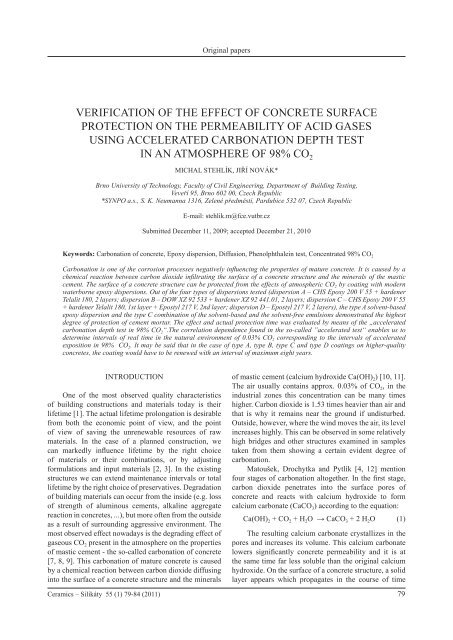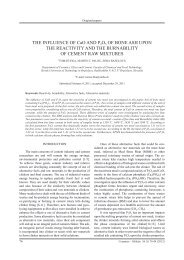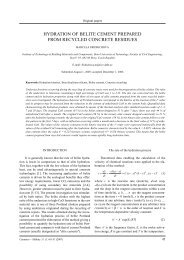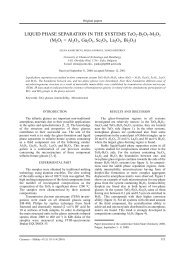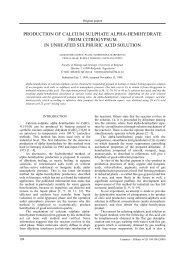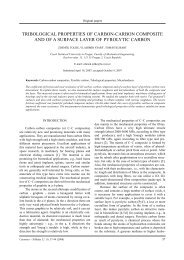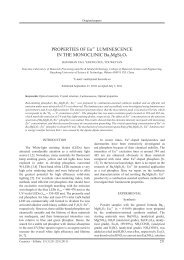Verification of the effect of concrete surface ... - Ceramics-Silikaty
Verification of the effect of concrete surface ... - Ceramics-Silikaty
Verification of the effect of concrete surface ... - Ceramics-Silikaty
Create successful ePaper yourself
Turn your PDF publications into a flip-book with our unique Google optimized e-Paper software.
Original papers<br />
VERIFICATION OF THE EFFECT OF CONCRETE SURFACE<br />
PROTECTION ON THE PERMEABILITY OF ACID GASES<br />
USING ACCELERATED CARBONATION DEPTH TEST<br />
IN AN ATMOSPHERE OF 98% CO 2<br />
MICHAL STEHLÍK, JIŘÍ NOVÁK*<br />
Brno University <strong>of</strong> Technology, Faculty <strong>of</strong> Civil Engineering, Department <strong>of</strong> Building Testing,<br />
Veveří 95, Brno 602 00, Czech Republic<br />
*SYNPO a.s., S. K. Neumanna 1316, Zelené předměstí, Pardubice 532 07, Czech Republic<br />
E-mail: stehlik.m@fce.vutbr.cz<br />
Submitted December 11, 2009; accepted December 21, 2010<br />
Keywords: Carbonation <strong>of</strong> <strong>concrete</strong>, Epoxy dispersion, Diffusion, Phenolphthalein test, Concentrated 98% CO 2<br />
Carbonation is one <strong>of</strong> <strong>the</strong> corrosion processes negatively influencing <strong>the</strong> properties <strong>of</strong> mature <strong>concrete</strong>. It is caused by a<br />
chemical reaction between carbon dioxide infiltrating <strong>the</strong> <strong>surface</strong> <strong>of</strong> a <strong>concrete</strong> structure and <strong>the</strong> minerals <strong>of</strong> <strong>the</strong> mastic<br />
cement. The <strong>surface</strong> <strong>of</strong> a <strong>concrete</strong> structure can be protected from <strong>the</strong> <strong>effect</strong>s <strong>of</strong> atmospheric CO 2 by coating with modern<br />
waterborne epoxy dispersions. Out <strong>of</strong> <strong>the</strong> four types <strong>of</strong> dispersions tested (dispersion A – CHS Epoxy 200 V 55 + hardener<br />
Telalit 180, 2 layers; dispersion B – DOW XZ 92 533 + hardener XZ 92 441.01, 2 layers; dispersion C – CHS Epoxy 200 V 55<br />
+ hardener Telalit 180, 1st layer + Epostyl 217 V, 2nd layer; dispersion D – Epostyl 217 V, 2 layers), <strong>the</strong> type A solvent-based<br />
epoxy dispersion and <strong>the</strong> type C combination <strong>of</strong> <strong>the</strong> solvent-based and <strong>the</strong> solvent-free emulsions demonstrated <strong>the</strong> highest<br />
degree <strong>of</strong> protection <strong>of</strong> cement mortar. The <strong>effect</strong> and actual protection time was evaluated by means <strong>of</strong> <strong>the</strong> „accelerated<br />
carbonation depth test in 98% CO 2“.The correlation dependence found in <strong>the</strong> so-called ”accelerated test“ enables us to<br />
determine intervals <strong>of</strong> real time in <strong>the</strong> natural environment <strong>of</strong> 0.03% CO 2 corresponding to <strong>the</strong> intervals <strong>of</strong> accelerated<br />
exposition in 98% CO 2. It may be said that in <strong>the</strong> case <strong>of</strong> type A, type B, type C and type D coatings on higher-quality<br />
<strong>concrete</strong>s, <strong>the</strong> coating would have to be renewed with an interval <strong>of</strong> maximum eight years.<br />
INTRODUCTION<br />
One <strong>of</strong> <strong>the</strong> most observed quality characteristics<br />
<strong>of</strong> building constructions and materials today is <strong>the</strong>ir<br />
lifetime [1]. The actual lifetime prolongation is desirable<br />
from both <strong>the</strong> economic point <strong>of</strong> view, and <strong>the</strong> point<br />
<strong>of</strong> view <strong>of</strong> saving <strong>the</strong> unrenewable resources <strong>of</strong> raw<br />
materials. In <strong>the</strong> case <strong>of</strong> a planned construction, we<br />
can markedly influence lifetime by <strong>the</strong> right choice<br />
<strong>of</strong> materials or <strong>the</strong>ir combinations, or by adjusting<br />
formulations and input materials [2, 3]. In <strong>the</strong> existing<br />
structures we can extend maintenance intervals or total<br />
lifetime by <strong>the</strong> right choice <strong>of</strong> preservatives. Degradation<br />
<strong>of</strong> building materials can occur from <strong>the</strong> inside (e.g. loss<br />
<strong>of</strong> strength <strong>of</strong> aluminous cements, alkaline aggregate<br />
reaction in <strong>concrete</strong>s, ...), but more <strong>of</strong>ten from <strong>the</strong> outside<br />
as a result <strong>of</strong> surrounding aggressive environment. The<br />
most observed <strong>effect</strong> nowadays is <strong>the</strong> degrading <strong>effect</strong> <strong>of</strong><br />
gaseous CO 2 present in <strong>the</strong> atmosphere on <strong>the</strong> properties<br />
<strong>of</strong> mastic cement - <strong>the</strong> so-called carbonation <strong>of</strong> <strong>concrete</strong><br />
[7, 8, 9]. This carbonation <strong>of</strong> mature <strong>concrete</strong> is caused<br />
by a chemical reaction between carbon dioxide diffusing<br />
into <strong>the</strong> <strong>surface</strong> <strong>of</strong> a <strong>concrete</strong> structure and <strong>the</strong> minerals<br />
<strong>of</strong> mastic cement (calcium hydroxide Ca(OH) 2) [10, 11].<br />
The air usually contains approx. 0.03% <strong>of</strong> CO 2, in <strong>the</strong><br />
industrial zones this concentration can be many times<br />
higher. Carbon dioxide is 1.53 times heavier than air and<br />
that is why it remains near <strong>the</strong> ground if undisturbed.<br />
Outside, however, where <strong>the</strong> wind moves <strong>the</strong> air, its level<br />
increases highly. This can be observed in some relatively<br />
high bridges and o<strong>the</strong>r structures examined in samples<br />
taken from <strong>the</strong>m showing a certain evident degree <strong>of</strong><br />
carbonation.<br />
Matoušek, Drochytka and Pytlík [4, 12] mention<br />
four stages <strong>of</strong> carbonation altoge<strong>the</strong>r. In <strong>the</strong> first stage,<br />
carbon dioxide penetrates into <strong>the</strong> <strong>surface</strong> pores <strong>of</strong><br />
<strong>concrete</strong> and reacts with calcium hydroxide to form<br />
calcium carbonate (CaCO 3) according to <strong>the</strong> equation:<br />
Ca(OH) 2 + CO 2 + H 2O → CaCO 3 + 2 H 2O (1)<br />
The resulting calcium carbonate crystallizes in <strong>the</strong><br />
pores and increases its volume. This calcium carbonate<br />
lowers significantly <strong>concrete</strong> permeability and it is at<br />
<strong>the</strong> same time far less soluble than <strong>the</strong> original calcium<br />
hydroxide. On <strong>the</strong> <strong>surface</strong> <strong>of</strong> a <strong>concrete</strong> structure, a solid<br />
layer appears which propagates in <strong>the</strong> course <strong>of</strong> time<br />
<strong>Ceramics</strong> – Silikáty 55 (1) 79-84 (2011) 79
and simultaneously, <strong>the</strong> pH value <strong>of</strong> <strong>concrete</strong>, which<br />
successfully ensured passivation <strong>of</strong> steel reinforcement<br />
before this input, decreases. This decrease in steel<br />
passivation is in fact <strong>the</strong> worst impact <strong>of</strong> carbonation in<br />
steel reinforced <strong>concrete</strong> [14].<br />
The second stage is mainly characterized by changes<br />
<strong>of</strong> o<strong>the</strong>r hydration products <strong>of</strong> mastic cement, moreover,<br />
due to <strong>the</strong> present humidity and CO 2, <strong>the</strong> resultant CaCO 3<br />
is fur<strong>the</strong>r converted into soluble Ca(HCO 3) 2 according to<br />
<strong>the</strong> equation:<br />
CaCO 3 + CO 2 + H 2O → Ca(HCO 3) 2 (2)<br />
In <strong>the</strong> third stage <strong>of</strong> carbonation, <strong>the</strong> previously<br />
originated carbonate formations recrystallize giving rise<br />
to very large calcite and aragonite crystals. The fourth<br />
stage is typical for its almost 100% carbonation. The third<br />
and fourth stage <strong>of</strong> carbonation worsen substantially <strong>the</strong><br />
strength characteristics <strong>of</strong> <strong>concrete</strong>, <strong>the</strong> pH decreases<br />
markedly; <strong>the</strong> fourth stage can already be a stimulus for<br />
<strong>the</strong> spontaneous destruction <strong>of</strong> <strong>concrete</strong> structure for <strong>the</strong><br />
reason <strong>of</strong> steel corrosion.<br />
The negative <strong>effect</strong>s <strong>of</strong> <strong>concrete</strong> carbonation can<br />
be prevented by designing a very high-quality <strong>concrete</strong><br />
mixture or by its very good compaction during concreting.<br />
As far as older <strong>concrete</strong> structures are concerned, it seems<br />
to be very prospective in <strong>the</strong> light <strong>of</strong> current knowledge,<br />
to protect <strong>the</strong>m additionaly by deep impregnation or<br />
by <strong>surface</strong> coatings on <strong>the</strong> basis <strong>of</strong> waterborne epoxy<br />
dispersions [6, 15]. The main advantage <strong>of</strong> <strong>the</strong> applied<br />
waterborne dispersions <strong>of</strong> epoxy resins, called “ec<strong>of</strong>riendly<br />
coatings” in <strong>the</strong> litrature, is lowering <strong>the</strong> content<br />
<strong>of</strong> solvent evaporation in <strong>the</strong> system. The oldest systems,<br />
<strong>the</strong> so-called dispersions <strong>of</strong> <strong>the</strong> 1 st type, are based on<br />
water-based low-molecular resins. Dispersions <strong>of</strong> <strong>the</strong><br />
2 nd type are based on <strong>the</strong> dispergation <strong>of</strong> a medium or<br />
higher-molecular resin in water, but <strong>the</strong>y contain a certain<br />
amount <strong>of</strong> solvent. The most modern dispersions <strong>of</strong> <strong>the</strong><br />
3rd type are epoxy dispersions containing no or very little<br />
organic solvent. Apart from epoxy resins and epoxymodified<br />
acrylates, <strong>the</strong>y <strong>of</strong>ten include compositions<br />
containing organosilanes. The above mentioned epoxy<br />
dispersions are applied in most cases as two-component<br />
coating compositions. Depending on <strong>the</strong> character <strong>of</strong> <strong>the</strong><br />
initial components, i.e. <strong>of</strong> both <strong>the</strong> dispersion itself, and<br />
<strong>the</strong> hardener, <strong>the</strong> resulting coating films have different<br />
properties.<br />
The main objective <strong>of</strong> <strong>the</strong> research work is to test<br />
<strong>the</strong> positive <strong>effect</strong> <strong>of</strong> waterborne epoxy protective<br />
coatings <strong>of</strong> <strong>the</strong> 2 nd and primarily <strong>of</strong> <strong>the</strong> 3 rd type on<br />
lowering or stopping <strong>the</strong> diffusion and subsequent<br />
permeation <strong>of</strong> <strong>the</strong> aggressive CO 2 into <strong>the</strong> depth <strong>of</strong><br />
cement mortar or <strong>concrete</strong> [13]. The applied coating,<br />
however, should not prevent <strong>the</strong> reverse penetration<br />
<strong>of</strong> moisture from <strong>the</strong> building or from <strong>the</strong> depth <strong>of</strong> <strong>the</strong><br />
structure into <strong>the</strong> atmosphere. In order to determine<br />
<strong>the</strong> susceptibility <strong>of</strong> <strong>concrete</strong> and mortar samples to<br />
carbonation, it can be used <strong>the</strong> procedure based on ČSN<br />
Stehlík M., Novák J.<br />
EN 13 295 „Resistance <strong>of</strong> repair products or systems<br />
to carbonation“, in which <strong>the</strong> test pieces are exposed to<br />
an atmosphere containing 1% CO 2 for <strong>the</strong> period <strong>of</strong> 56<br />
days. However, <strong>the</strong> testing application <strong>of</strong> waterborne<br />
epoxy resins to <strong>the</strong> <strong>surface</strong> <strong>of</strong> <strong>concrete</strong> results in <strong>the</strong><br />
formation <strong>of</strong> a barrier preventing <strong>the</strong> diffusion <strong>of</strong> CO 2.<br />
From this point <strong>of</strong> view, <strong>the</strong> exposition period <strong>of</strong> 56 days<br />
determined by <strong>the</strong> standard in an atmosphere with only<br />
1% CO 2 seems to be very short. The Institute <strong>of</strong> Building<br />
Testing in <strong>the</strong> Faculty <strong>of</strong> Civil Engineering (Brno<br />
University <strong>of</strong> Technology) developed a more suitable<br />
procedure for <strong>the</strong> determination <strong>of</strong> <strong>the</strong> real carbonation<br />
depth. It is an „accelerated carbonation depth test in 98%<br />
CO 2“ [16]. This method is based on <strong>the</strong> finding that <strong>the</strong><br />
speed <strong>of</strong> carbonation in an environment <strong>of</strong> concentrated<br />
98% CO 2 constantly increases in comparison with <strong>the</strong><br />
natural environment containing 0.03% CO 2.<br />
EXPERIMENTAL<br />
The <strong>effect</strong> <strong>of</strong> coating <strong>the</strong> <strong>surface</strong> <strong>of</strong> mortar or <strong>concrete</strong><br />
with waterborne epoxy dispersions on <strong>the</strong> permeability<br />
for <strong>the</strong> aggressive CO2 [15] was tested on standard<br />
mortar beams with dimensions <strong>of</strong> 40×40×160 mm, made<br />
mostly according to <strong>the</strong> three basic formulations labeled<br />
1, 2 and 3 - see Table 1.<br />
After stripping <strong>of</strong>f, <strong>the</strong> mortar beams according to<br />
<strong>the</strong> formulations 1, 2 and 3 were placed under water for<br />
28 days, and <strong>the</strong>n <strong>the</strong>ir moisture content was modified<br />
to approximately 1% <strong>of</strong> moisture by gradual drying out<br />
in <strong>the</strong> laboratory. The following four combinations <strong>of</strong><br />
waterborne dispersions including hardeners were applied<br />
separately to a selected number <strong>of</strong> standard mortar beams<br />
according to <strong>the</strong> formulations 1, 2 and 3 [3, 15]:<br />
a) coating A - 2 layers <strong>of</strong> dispersion CHS Epoxy 200 V<br />
55 + hardener Telalit 180,<br />
b) coating B - 2 layers <strong>of</strong> dispersion DOW XZ 92533 +<br />
+ hardener XZ 92441.01,<br />
c) coating C - 1 layer <strong>of</strong> dispersion CHS Epoxy 200 V<br />
55 + hardener Telalit 180 and 1 layer <strong>of</strong><br />
dispersion Epostyl 217 V,<br />
d) coating D - 2 layers <strong>of</strong> dispersion Epostyl 217 V.<br />
The resin used for <strong>the</strong> <strong>surface</strong> protection CHS<br />
Epoxy 200 V 55 is <strong>the</strong> water dispersion <strong>of</strong> a medium<br />
molecular weight epoxy resin. The system consists <strong>of</strong><br />
a modified epoxy resin and a special hardener Telalit<br />
180. The viscosity <strong>of</strong> <strong>the</strong> resin (25°C) ranges from 0.1-<br />
0.7 Pa.s according to DIN 53015. The content <strong>of</strong> nonvolatile<br />
matters (2 h/140°C) varies from 54-58 wt.%<br />
in accordance with ISO 3251. The hardener Telalit 180<br />
is a universal hardener for CHS Epoxy waterborne<br />
epoxy systems. Telalit 180 is a water-based solution<br />
<strong>of</strong> an epoxy-polyamine adduct. Its viscosity (25°C)<br />
ranges from 0.75-1.1 Pa.s according to DIN 53015.<br />
The recommended mixing ratio <strong>of</strong> CHS Epoxy 200<br />
V 55 : Telalit 180 is 100pbw. : 27pbw.<br />
80 <strong>Ceramics</strong> – Silikáty 55 (1) 79-84 (2011)
<strong>Verification</strong> <strong>of</strong> <strong>the</strong> <strong>effect</strong> <strong>of</strong> <strong>concrete</strong> <strong>surface</strong> protection on <strong>the</strong> permeability <strong>of</strong> acid gases using accelerated carbonation depth...<br />
Table 1. Mortar mixture formulations for making standard beams 40×40×160 mm.<br />
Estimated crushing Actual crushing Amount <strong>of</strong> fine Amount <strong>of</strong> cement Amount <strong>of</strong> Number<br />
Formulation strength 28 days strength 28 days aggregate CemI 42,5R batch water <strong>of</strong> samples<br />
identification (MPa) (MPa) (g) (g) (ml) (piece)<br />
1 15.0 11.0 1600.0 200.0 185.0 30<br />
2 25.0 24.0 1475.0 325.0 200.0 30<br />
3 35.0 37.0 1350.0 450.0 212.0 32<br />
The Epostyl 217 coating system is a two-component<br />
system based on <strong>the</strong> dispersion CHS Epoxy 160 V 55<br />
(waterborne solvent-free solid epoxy dispersion) and a<br />
hardener. The mixing ratio is 1 : 1.<br />
DOW XZ 92 533 is a waterborne epoxy disper-<br />
sion from DOW Chemicals Ltd. Its viscosity (23°C) is<br />
0.497 Pa.s according to ČSN 64 0349. The content <strong>of</strong><br />
non-volatile matters (2h/130°C) is 46.7% wt. in accordance<br />
with ČSN EN ISO 3251. It is suitable to use <strong>the</strong><br />
hardener XZ 92 441.01 from DOW. The recommended<br />
mixing ratio <strong>of</strong> DOW XZ 92 533 : XZ 92 441.01 is<br />
100 pbw. : 20 pbw.<br />
The selected sets <strong>of</strong> samples (some <strong>surface</strong> treated<br />
with a dispersion coating and some not) were placed in<br />
a slightly pressurized (approx. 20 mm water column)<br />
tank with a concentration <strong>of</strong> 98% CO 2 for <strong>the</strong> purpose<br />
<strong>of</strong> accelerating <strong>the</strong> carbonation test - see Figure 1. The<br />
remaining samples without <strong>surface</strong> treatment were left in<br />
<strong>the</strong> natural environment <strong>of</strong> <strong>the</strong> laboratory (0.03% CO 2)<br />
as reference samples.<br />
The method for <strong>the</strong> determination <strong>of</strong> resistance<br />
<strong>of</strong> <strong>concrete</strong> treated with waterborne epoxy emulsion<br />
coatings to <strong>the</strong> <strong>effect</strong>s <strong>of</strong> aggressive CO 2 is based on a<br />
comparison <strong>of</strong> carbonation depths <strong>of</strong> <strong>the</strong> treated (see<br />
Figure 2) and untreated samples placed in an aggressive<br />
environment <strong>of</strong> 98% CO 2. In <strong>the</strong> <strong>surface</strong> untreated<br />
samples, <strong>the</strong> carbonation depth from <strong>the</strong> accelerated<br />
test can be moreover compared to <strong>the</strong> depth <strong>of</strong> natural<br />
carbonation in <strong>the</strong> laboratory environment with approx.<br />
0.03% CO 2. What seems to be a great problem is <strong>the</strong><br />
determination <strong>of</strong> a real acceleration <strong>of</strong> <strong>the</strong> test in 98% CO 2<br />
compared to <strong>the</strong> natural atmosphere. Here it is necessary<br />
to start with <strong>the</strong> essence <strong>of</strong> <strong>the</strong> so-called “accelerated<br />
test” described shortly in <strong>the</strong> following paragraph and in<br />
more detail in <strong>the</strong> publication [16] by <strong>the</strong> author.<br />
According to ČSN EN 13 295, it is possible to<br />
determine <strong>the</strong> resistance <strong>of</strong> repair products or systems to<br />
carbonation by means <strong>of</strong> an accelerated laboratory test,<br />
in which <strong>the</strong> test pieces are exposed to an atmosphere<br />
containing 1% CO 2 for a period <strong>of</strong> 56 days. This standard<br />
test serves in fact as a sort <strong>of</strong> initial elimination criterion<br />
for <strong>the</strong> selection <strong>of</strong> optimum repair mortars or <strong>concrete</strong>s<br />
for application to <strong>the</strong> restored structure. However, it<br />
does not say much about <strong>the</strong> actual depth or extent <strong>of</strong><br />
damage caused to <strong>the</strong> structure by carbonation in <strong>the</strong><br />
middle or at <strong>the</strong> end <strong>of</strong> its lifetime. When deriving <strong>the</strong><br />
correlation dependence <strong>of</strong> accelerated time / natural<br />
time, it was necessary to compare <strong>the</strong> real carbonation<br />
depth <strong>of</strong> <strong>concrete</strong>s exposed to <strong>the</strong> long-lasting <strong>effect</strong>s<br />
<strong>of</strong> <strong>the</strong> natural atmosphere with <strong>the</strong> carbonation depth <strong>of</strong><br />
comparative <strong>concrete</strong>s in an environment <strong>of</strong> 98% CO 2.<br />
A transition from <strong>the</strong> standard 1% CO 2 to <strong>the</strong> 98% CO 2<br />
was called for by accelerating <strong>the</strong> chemical process<br />
<strong>of</strong> carbonation and by <strong>the</strong> financial expensiveness <strong>of</strong><br />
obtaining 1% CO 2 (from Belgium). A problem <strong>of</strong> <strong>the</strong><br />
correlation serched here will always be <strong>the</strong> absence <strong>of</strong><br />
real pairs <strong>of</strong> <strong>the</strong> originally identical <strong>concrete</strong> samples for<br />
<strong>the</strong> determination <strong>of</strong> carbonation depth, one <strong>of</strong> which was<br />
(or is) exposed to decades <strong>of</strong> slow <strong>effect</strong>s <strong>of</strong> carbonation<br />
in <strong>the</strong> structure and <strong>the</strong> o<strong>the</strong>r one <strong>of</strong> which undergoes a<br />
comparative accelerated test in 98% CO 2.<br />
Figure 1. Complete pressurized tank with an atmoshere <strong>of</strong><br />
98% CO 2.<br />
Figure 2. 12 th month <strong>of</strong> placement in 98% CO 2, coating A, B, C<br />
and D for formulations 1, 2 and 3, average carbonation depths<br />
under <strong>the</strong> coating A: 1, 3, 0 mm, B: 20, 5, 1 mm, C: 2, 1, 2 mm<br />
and D: 15, 15, 0 mm.<br />
<strong>Ceramics</strong> – Silikáty 55 (1) 79-84 (2011) 81
Stehlík M., Novák J.<br />
Figure 3. Different carbonation depths in an atmosphere <strong>of</strong> 98% CO 2 and in <strong>the</strong> natural atmosphere both <strong>the</strong>oretically and<br />
practically.<br />
Figure 4. Acceleration <strong>of</strong> <strong>the</strong> carbonation depth test in 98%<br />
CO 2.<br />
Carbonation depth <strong>of</strong> common <strong>concrete</strong> placed in<br />
<strong>the</strong> natural atmosphere (0.03% CO 2) for a long time can<br />
be determined by calculation according to many authors<br />
(e.g. Henning, Lach [10], Matoušek, Drochytka [4], Seng<br />
Diep [11], Houst, Wittmann [17]). The relation according<br />
to [10] seems to be <strong>the</strong> most general one, <strong>the</strong> so-called<br />
Fick’s law in <strong>the</strong> following form<br />
x = k·√t (3)<br />
which is based on <strong>the</strong> principle <strong>of</strong> a constant increase <strong>of</strong><br />
carbonation depth with time. X indicates <strong>the</strong> depth <strong>of</strong><br />
<strong>the</strong> carbonated layer in mm, t is <strong>the</strong> time in days and k is<br />
<strong>the</strong> constant ranging from 0.2 to 0.4 (depending on <strong>the</strong><br />
cement type and <strong>the</strong> water ratio v/c). It is apparent that <strong>the</strong><br />
carbonation depth will be, according to <strong>the</strong> measurements<br />
carried out on <strong>the</strong> standard samples, partially dependent<br />
on <strong>the</strong> quality <strong>of</strong> <strong>concrete</strong>. It is also interesting that <strong>the</strong><br />
increase <strong>of</strong> carbonation depth calculated according<br />
to <strong>the</strong> Fick’s law [10] is roughly corresponding to <strong>the</strong><br />
carbonation depths found out in poor quality <strong>concrete</strong>s<br />
in <strong>the</strong> course <strong>of</strong> <strong>the</strong> one-year measurement. Figure 3<br />
shows a conventional curve <strong>of</strong> <strong>the</strong> increase <strong>of</strong> carbonation<br />
depth derived <strong>the</strong>oretically from <strong>the</strong> Fick’s law on <strong>the</strong><br />
one hand and from <strong>the</strong> one-year practical measurement<br />
in an environment <strong>of</strong> 0.03% CO 2 on <strong>the</strong> o<strong>the</strong>r hand, and<br />
simultaneously a growth curve for average <strong>concrete</strong> (30<br />
MPa in compression) determined by measurement in an<br />
environment <strong>of</strong> 98% CO 2.<br />
It is apparent from <strong>the</strong> chart in Figure 4 and from<br />
<strong>the</strong> following Table 2 that <strong>the</strong> speed <strong>of</strong> carbonation<br />
in an environment <strong>of</strong> concentrated 98% CO 2 constantly<br />
increases in comparison with <strong>the</strong> natural environment<br />
containing 0.03% CO 2. If <strong>the</strong> carbonation depth measured<br />
in <strong>the</strong> tested <strong>concrete</strong> in <strong>the</strong> accelerated test after<br />
two months <strong>of</strong> placement in 98% CO 2 is 10 mm, <strong>the</strong>n<br />
<strong>the</strong> same damage in <strong>the</strong> real environment <strong>of</strong> 0.03%<br />
CO 2 would occur in 312 days (10.4 months) - see<br />
Figure 4. However, <strong>the</strong> dependence between <strong>the</strong> time <strong>of</strong><br />
corresponding damage <strong>of</strong> <strong>concrete</strong>s in <strong>the</strong> concentrated<br />
and natural environments was determined for samples<br />
<strong>of</strong> common <strong>concrete</strong> with a 28-day strength <strong>of</strong> approx.<br />
30 MPa.<br />
RESULTS AND DISCUSSION<br />
The real carbonation depth <strong>of</strong> both <strong>surface</strong> treated<br />
and <strong>surface</strong> untreated mortar beams was always determined<br />
on both fragments <strong>of</strong> beams according to prEN<br />
14630:2003, Paragraph 4.2. This is an indication <strong>of</strong><br />
sound <strong>concrete</strong> by phenolphthalein (purple colouring)<br />
at pH > 9,4. The mutual comparison <strong>of</strong> carbonation<br />
depths <strong>of</strong> both <strong>the</strong> coated and uncoated samples (placed<br />
in 98% CO 2 and in <strong>the</strong> natural atmosphere <strong>of</strong> <strong>the</strong><br />
laboratory) was carried out in <strong>the</strong> following chronological<br />
order starting from <strong>the</strong> date <strong>of</strong> placement into 98%<br />
CO 2: 1 month, 2 months, 4 months, 6 months and <strong>the</strong><br />
last measurement after 12 months <strong>of</strong> placement in 98%<br />
CO 2. Following is a quick evaluation <strong>of</strong> <strong>the</strong> state <strong>of</strong><br />
carbonation <strong>of</strong> standard beams after <strong>the</strong> above mentioned<br />
time intervals.<br />
82 <strong>Ceramics</strong> – Silikáty 55 (1) 79-84 (2011)
<strong>Verification</strong> <strong>of</strong> <strong>the</strong> <strong>effect</strong> <strong>of</strong> <strong>concrete</strong> <strong>surface</strong> protection on <strong>the</strong> permeability <strong>of</strong> acid gases using accelerated carbonation depth...<br />
Table 2. Comparison <strong>of</strong> carbonation times <strong>of</strong> <strong>the</strong> identical layers <strong>of</strong> <strong>concrete</strong> in <strong>the</strong> environment <strong>of</strong> a real atmosphere (0.03% CO 2)<br />
and in <strong>the</strong> highly concentrated environment <strong>of</strong> 98% CO 2.<br />
Carbonation Atmospheric CO 2 (0.03%) Concentrated CO 2 (98%) Ratio<br />
depth exposure time - T 1 exposure time - T 2 T 1/T 2<br />
(mm) (days) (days)<br />
5 132 60 2.2<br />
10 520 100 5.2<br />
15 1080 140 7.7<br />
20 1680 160 10.5<br />
25 2700 200 13.5<br />
30 3700 220 16.8<br />
End <strong>of</strong> <strong>the</strong> 1 st month <strong>of</strong> placement: All <strong>the</strong> four types<br />
<strong>of</strong> coating, A, B, C and D, protected <strong>the</strong> samples <strong>of</strong> three<br />
types <strong>of</strong> tested mortars (formulations 1, 2 and 3) placed<br />
in 98% CO 2 quite reliably. Moreover, it is possible to<br />
say that in <strong>the</strong> first month <strong>the</strong> coatings had an apparent<br />
positive <strong>effect</strong> on <strong>the</strong> regtrogressive „recovery“ <strong>of</strong> <strong>the</strong><br />
cement mortar. During carbonation, water appears as<br />
its by-product contributing to a secondary hydration <strong>of</strong><br />
<strong>the</strong> yet non-hydrated components <strong>of</strong> mastic cement, and<br />
that is why purple colouring can be seen all over <strong>the</strong><br />
fracture area <strong>of</strong> <strong>the</strong> beam fractures. In <strong>the</strong> case <strong>of</strong> beams<br />
not protected by coating, positive influence <strong>of</strong> <strong>concrete</strong><br />
quality on preventing <strong>the</strong> diffusion <strong>of</strong> aggressive CO 2<br />
into <strong>the</strong> material is apparent.<br />
End <strong>of</strong> <strong>the</strong> 2 nd month <strong>of</strong> placement: It seems that <strong>the</strong><br />
coatings labeled A and B protected <strong>the</strong> cement mortar<br />
in an environment <strong>of</strong> 98% CO 2 better than <strong>the</strong> coatings<br />
C and D, never<strong>the</strong>less, in all four types <strong>of</strong> <strong>surface</strong><br />
protection <strong>the</strong> measured carbonation depth ranged, for<br />
<strong>the</strong> time being, from 0.5 to 3 mm according to <strong>the</strong> quality<br />
<strong>of</strong> <strong>the</strong> cement mortar.<br />
End <strong>of</strong> <strong>the</strong> 4 th month <strong>of</strong> placement: After 4 weeks<br />
(120 days), <strong>the</strong> samples treated with type A, B, C and<br />
D coatings demonstrated a higher permeability for a<br />
concentrated 98% CO 2, type C and D coatings, naturally,<br />
depending on <strong>the</strong> quality <strong>of</strong> <strong>the</strong> protected cement mortar.<br />
End <strong>of</strong> <strong>the</strong> 6 th month <strong>of</strong> placement: The protective<br />
<strong>effect</strong> <strong>of</strong> dispersion coatings has changed compared to<br />
<strong>the</strong> results from two months ago (4 months <strong>of</strong> placement<br />
in CO 2), <strong>the</strong> low-quality cement mortar which is <strong>the</strong>refore<br />
most susceptible to carbonation is best protected by types<br />
A and C coatings.<br />
End <strong>of</strong> <strong>the</strong> 12 th month <strong>of</strong> placement: The highest<br />
degree <strong>of</strong> protection was demonstrated by type A solvent-based<br />
epoxy emulsion and by a combination <strong>of</strong> <strong>the</strong><br />
solvent-based and <strong>the</strong> solvent-free one (type C) - see<br />
Figure 2.<br />
As far as <strong>the</strong> protective properties <strong>of</strong> all four types<br />
<strong>of</strong> <strong>the</strong> tested waterborne epoxy dispersions A, B, C and<br />
D in realation to <strong>the</strong> penetration <strong>of</strong> CO 2 are concerned,<br />
<strong>the</strong> one-year accelerated test (corresponding to approx.<br />
8 years <strong>of</strong> real atmospheric <strong>effect</strong> <strong>of</strong> 0.03% CO 2 on<br />
medium-quality <strong>concrete</strong> - derived from Figure 4)<br />
brought <strong>the</strong> following findings:<br />
● The highest degree <strong>of</strong> protection <strong>of</strong> cement mortar was<br />
demonstrated by type A epoxy emulsion and by type<br />
C combination <strong>of</strong> <strong>the</strong> solvent-based and solvent-free<br />
emulsions (in both cases <strong>the</strong> first type A impregnation<br />
coating is identical).<br />
● Full protection <strong>of</strong> quality cement mortars was<br />
provided identically by all <strong>the</strong> tested waterborne<br />
epoxy dispersions <strong>of</strong> type A, B, C and D.<br />
● Cement mortar <strong>of</strong> poor quality was not reliably<br />
protected for <strong>the</strong> period <strong>of</strong> 6 or more months (in fact<br />
5 and more years - derived from Figure 4) by type B<br />
solvent-based foreign epoxy emulsion.<br />
Never<strong>the</strong>less, in <strong>the</strong> carbonation depth test after 4<br />
months <strong>of</strong> placement in a concentrated 98% CO 2 (in fact<br />
3 years!), both coatings, types B nad D, quite reliably<br />
reduced <strong>the</strong> penetration <strong>of</strong> CO 2 into cement mortar.<br />
Therefore, in <strong>the</strong> case <strong>of</strong> application <strong>of</strong> types A and C<br />
coatings on poor quality <strong>concrete</strong>, <strong>the</strong> coating would<br />
have to be renewed after a max. <strong>of</strong> 8 years, in <strong>the</strong> case<br />
<strong>of</strong> types B and D coatings, after a max. <strong>of</strong> 3 years. In<br />
<strong>the</strong> case <strong>of</strong> type A, type B, type C and type D coatings<br />
on higher-quality <strong>concrete</strong>s, <strong>the</strong> coating would have to<br />
be renewed with an interval <strong>of</strong> maximum eight years -<br />
see Table 3. The renewal intervals <strong>of</strong> <strong>the</strong> coatings were<br />
derived from <strong>the</strong> continuous evaluation <strong>of</strong> <strong>the</strong> progress<br />
<strong>of</strong> carbonation using <strong>the</strong> phenolphthalein test on <strong>the</strong> test<br />
beams over a period <strong>of</strong> one year.<br />
When comparing modern solvent-free epoxy dispersions<br />
<strong>of</strong> <strong>the</strong> D-type (Epostyl 217) tested here with<br />
nowadays standard products <strong>of</strong> <strong>the</strong> building chemistry<br />
manufacturers, it is necessary to take into account that<br />
<strong>the</strong> overwhelming majority <strong>of</strong> dispersions used is based<br />
Table 3. Comparison <strong>of</strong> carbonation times <strong>of</strong> <strong>the</strong> identical<br />
layers <strong>of</strong> <strong>concrete</strong> in <strong>the</strong> environment <strong>of</strong> a real atmosphere<br />
(0.03% CO 2) and in <strong>the</strong> highly concentrated environment <strong>of</strong><br />
98% CO 2.<br />
Formulation/coating A B C D<br />
type-renewal interval (years) (years) (years) (years)<br />
Formulation 1 8 3 8 3<br />
Formulation 2 8 5 8 3<br />
Formulation 3 8 8 8 8<br />
<strong>Ceramics</strong> – Silikáty 55 (1) 79-84 (2011) 83
on <strong>the</strong> acrylic and tar-epoxy compositions. For example<br />
<strong>the</strong> Fosroc Limited company developed anti-carbonation<br />
paints <strong>of</strong> <strong>the</strong> elastomeric acrylic and acrylic-silane types.<br />
Two Czech companies, Spolek pro chemickou a hutní<br />
výrobu Ústí nad Labem and Panbex, produce a watertight<br />
tar-epoxy two-component compound. The disadvantage<br />
<strong>of</strong> <strong>the</strong>se systems is <strong>the</strong>ir low vapour permeability and <strong>the</strong><br />
resulting risk <strong>of</strong> damage to both <strong>the</strong> paint and <strong>the</strong> <strong>surface</strong><br />
layer <strong>of</strong> <strong>concrete</strong> in <strong>the</strong> spring months. At <strong>the</strong> Conference<br />
on Coating Compositions held in Pardubice, Czech<br />
Republic, in May 2000 [18], <strong>the</strong> development <strong>of</strong> a new<br />
two-component dispersion coating was presented, which<br />
became <strong>the</strong> subject <strong>of</strong> <strong>the</strong> applied research presented here.<br />
A similar coating was developed also by <strong>the</strong> chemical<br />
concern DOW Chemicals Ltd. (DOW XZ 92 533). This<br />
substance was not subjected to <strong>the</strong> test <strong>of</strong> protection<br />
against <strong>concrete</strong> carbonation by <strong>the</strong> manufacturer, but it<br />
was used as a reference in this research.<br />
CONCLUSIONS<br />
The results supplement a general picture <strong>of</strong> <strong>the</strong><br />
quality and usefulness <strong>of</strong> <strong>surface</strong> protection <strong>of</strong> mortars and<br />
<strong>concrete</strong>s against diffusion <strong>of</strong> atmospheric CO 2. Figure<br />
2 is a synoptic evaluation <strong>of</strong> <strong>the</strong> quality <strong>of</strong> protection <strong>of</strong><br />
cement mortar beams <strong>of</strong> 3 formulations by four types <strong>of</strong><br />
coating compositions A, B, C and D. The samples were<br />
placed for 12 months in an environment <strong>of</strong> concentrated<br />
98% CO 2. It is apparent that mortars and <strong>concrete</strong>s <strong>of</strong><br />
poorer quality (low strength, low compaction, excess <strong>of</strong><br />
gauging water) will be more susceptible to carbonation,<br />
and that protective coatings should mainly be applied<br />
to <strong>the</strong>se types <strong>of</strong> <strong>concrete</strong>s. Better quality <strong>concrete</strong>s are<br />
resistant to <strong>the</strong> diffusion <strong>of</strong> gaseous CO 2 <strong>the</strong>mselves to<br />
a certain extent (lower absorption capacity, porosity).<br />
A comparison <strong>of</strong> carbonation depths in both coated and<br />
uncoated samples <strong>of</strong> <strong>the</strong> best formulation (Formulation<br />
3 - compression strength 37 MPa) demonstrates however<br />
that <strong>surface</strong> coating with waterborne epoxy dispersions<br />
prevents even a minimum penetration <strong>of</strong> gaseous CO 2 into<br />
high-quality cement mortars, and its purpose is <strong>the</strong>refore<br />
not purely preventive. A big advantage <strong>of</strong> dispersion<br />
coatings is moreover <strong>the</strong> possibility <strong>of</strong> <strong>the</strong>ir application<br />
on wet <strong>surface</strong>s even at relatively low temperatures.<br />
Fur<strong>the</strong>r increase <strong>of</strong> <strong>effect</strong>iveness <strong>of</strong> coating systems<br />
in view <strong>of</strong> <strong>the</strong> permeability <strong>of</strong> acid gases can be achieved<br />
by an appropriate choice <strong>of</strong> aggregates with a barrier<br />
<strong>effect</strong>, and this is where fur<strong>the</strong>r research should be<br />
performed. It would also be beneficial to pay attention<br />
to <strong>the</strong> physical properties and mechanisms <strong>of</strong> composite<br />
action <strong>of</strong> <strong>the</strong> coating and various <strong>concrete</strong> <strong>surface</strong>s to<br />
eliminate <strong>the</strong> traditional defects <strong>of</strong> <strong>the</strong> coating systems,<br />
e.g. poor permeability and <strong>the</strong> resulting damage to <strong>the</strong><br />
coating-protected <strong>surface</strong> <strong>of</strong> <strong>the</strong> <strong>concrete</strong> structure due to<br />
<strong>the</strong> excess pressure <strong>of</strong> water vapour.<br />
Stehlík M., Novák J.<br />
Acknowledgement<br />
This work was supported by Research Project <strong>of</strong> <strong>the</strong><br />
Ministry <strong>of</strong> Education and Youth <strong>of</strong> <strong>the</strong> Czech Republic<br />
No. VVZ MSM 0021630511 „Progressive Building<br />
Materials with Utilization <strong>of</strong> Secondary Raw Materials<br />
and <strong>the</strong>ir Impact on Structures Durability“ and <strong>of</strong> <strong>the</strong><br />
Ministry <strong>of</strong> Industry and Trade <strong>of</strong> <strong>the</strong> Czech Republic No.<br />
MPO ČR. FT-TA3/056 „Waterborne epoxy dispersion <strong>of</strong><br />
new generation“.<br />
References<br />
1. Šmerda Z. et al.: Life <strong>of</strong> <strong>concrete</strong> structures, 1 st ed., p.89-<br />
170, ČKAIT, Praha 1999.<br />
2. Schulze W., Tischer W., Ettel W., Lach V.: Non-cement<br />
mortars and <strong>concrete</strong>s, 1 st ed., p.237-255, SNTL, Praha<br />
1990.<br />
3. Sebők T.: Additives and admixtures to mortars and <strong>concrete</strong>s,<br />
1 st ed., p.133-139, SNTL, Praha 1985.<br />
4. Matoušek M., Drochytka R.: Atmospheric corrosion <strong>of</strong><br />
<strong>concrete</strong>, 1 st ed., p.10-75, IKAS+ČKAIT, Praha 1998.<br />
5. Kovarčík I., Vávra Z.: Costruction & Interior, 15 (2009).<br />
6. Lőffelmannová I., Široká P.: Costruction & Interior, 22<br />
(2003).<br />
7. Bob C., Afana E. in: On-site assesment <strong>of</strong> <strong>concrete</strong><br />
carbonation, Proc. Inter. Confer. Failure <strong>of</strong> Concrete<br />
Structures, p. 84-87, Štrbské Pleso, Slovak Republic 1993<br />
8. Dhir R.K., Hewlett P.C., Chan Y.N.: Mag. Concr. Res. 148,<br />
137 (1989).<br />
9. Jungermann V.B.: Betonwerk Fertigteil Technik 6, 358<br />
(1982).<br />
10. Henning O., Lach V.: Chemistry in building industry,<br />
1 st ed., p.63-69, SNTL, Praha 1983.<br />
11. Diep S., Šlopková K.: Influence <strong>of</strong> <strong>concrete</strong> carbonation on<br />
<strong>the</strong> corrosion <strong>of</strong> ferro<strong>concrete</strong> elements, 1 st ed., p.36-56,<br />
TU Žilina, Žilina 2000.<br />
12. Pytlík P.: Concrete technology, 2 nd ed., p.304-310 a 366-<br />
371, VUTIUM, Brno 2000.<br />
13. Šauman Z.: Introduction to general physical chemistry<br />
and fundamentals <strong>of</strong> physical chemistry <strong>of</strong> silicates, 1 st ed.,<br />
p.140-159, SNTL, Praha 1965.<br />
14. Vavřín F., Retzl K.: Protection <strong>of</strong> building structures from<br />
corrosion, 1 st ed., p.11-130, SNTL, Praha 1987.<br />
15. Pichrt A.: Chemical revue, 10 (1986).<br />
16. Stehlík M. in: Principle <strong>of</strong> <strong>the</strong> accelerated carbonation<br />
depth test in 98% CO 2, p.115-117, Ed. Kořenská M.,<br />
Pazdera L., Academic Press Cerm s.r.o., Brno 2008.<br />
17. Houst Y.F., Wittmann F.H.: Depth pr<strong>of</strong>iles <strong>of</strong> carbonates<br />
formed during natural carbonation, Cem. Concr. Res. 32,<br />
1923-1930 (2002).<br />
18. Novák J. in: Concrete coatings, Proc. Inter. Confer. Conference<br />
on Coating Composition, p. 62-67, University <strong>of</strong><br />
Pardubice, Pardubice, Czech Republic 2000.<br />
84 <strong>Ceramics</strong> – Silikáty 55 (1) 79-84 (2011)


